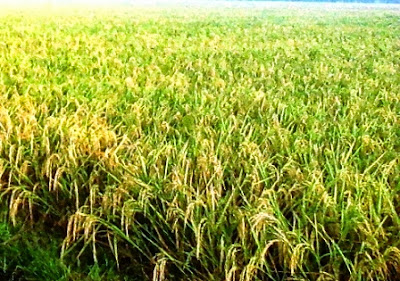 |
| The seeds |
Pangium edule is a tall tree native to the rivers banks and mangrove swamps of Southeast Asia (Indonesia, Malaysia, and Papua New Guinea). The fruit of Pangium edule has its native name keluak, keluwak, pucung, or picung in Indonesia and kepayang in Malay. Pangium edule fruit is a large poisonous fruit, however, through the fermentation process, local residents of the area can change the fruit seeds become an important part of the region's culinary.
Characteristic of the tree:
Kluwek or kepayang is a straight trunked tree; capable of reaching 60 feet high with a trunk diameter of up to 120 cm. Branches are not too tight. The leaves are heart-shaped, with a width of 15 cm. and length 20-cm. dark green and shiny on top, while the bottom is rather whitish and slightly hairy.
This plant grows in the wet tropical rainforest and is a native plant that grows from Southeast Asia to the western Pacific. Kepayang Flacourtiaceae family member who is able to grow in the lowlands up to an altitude of 1,500 m above sea level.
This tree has a taproot, strong and buttresses. While the woody stem, whitish green to gray, round shape and has haired young branches. The plants begin to bear fruit at the age of 6-10 years continuously, especially during the rainy season.
Kepayang or keluwek (Pangium edule) flowers grown in twig, greenish white, similar to papaya flowers. Flower-shaped is bunches and the crown has a length of 5-8 cm.
Kepayang fruit is elliptical with a tapered tip and base portion, a length of 30 cm and width 20-cm. Kepayang fruit shape like a rugby ball or American football. Fruit skin color is brown, with a slightly hairy surface.
White flesh and soft. A very hard shell, asymmetrical shape, protects Kepayang seed; with a size of 3-4 cm. Seed shell has a texture with blackish brown color. Shell thickness between three sd. 4 mm. Very white flesh colored seeds. Traditionally used by humans is a fruit seed meat, of course after the fermentation process.
The content and Utilization:
As the name suggests, this plant is able to make people become kepayang (drunk or hungover). This is because, particularly seeds, contain high concentrations of cyanide. Cyanide addition, several other chemical constituents contained in the fruit kepayang (Pangium edule), including vitamin C, iron ions, beta-carotene, hidnokarpat acid, acid khaulmograt, glorat acid, and tannins.
.JPG) |
| Seed and the pulp after fermentation |
Various substances that make the kepayang, keluwek, Picung or Pangium edule has a wide range of benefits and uses, such as julienne materials (rods), anthelmintic (leaf), antiseptic, bug remover, preservatives, and material for oil (seeds).
Kepayang fruit has another major benefit that is as important herbs in Indonesia and Malaysia: Rawon (Black Soup) is one of the favorite dishes of Indonesia are in absolute need to the seeds of this fruit as the marinade.
To eliminate cyanide acid content, fruit kepayang or kluwek (Pangium edule) which have matured and fallen from a tree collected in a sack and left wet by the rain or even soaked in water within 10-14 days. The fermentation process occurs in the process and content of beef stew with beans will change from white to black.
Substances and essential vitamins in fruit seeds kluwek:
Vitamin C, iron ions, beta-carotene, acid cyanide (poisonous nature, easily evaporate at a temperature of 26 degrees Celsius, if inhaled can lead to the death of animals, safe for fish preservation), hydnocarpate acid, chaulmoogras acid, chlorate Acid and Tannins (as preservative fish).
Nutritional value per 100 g (3.5 oz):
(Source: USDA Nutrient Database)
- Energy 462 kJ (110 kcal)
- Carbohydrates 23.9 g
- - Sugars 14.1 g
- - Dietary fiber 6.2 g
- Fat 2 g
- Protein 2.3 g
- Vitamin A equiv. 19 µg (2%)
- - beta-carotene 230 µg (2%)
- Vitamin C 25.8 mg (31%)
- Calcium 15 mg (2%)
- Iron 2.2 mg (17%)
- Magnesium 32 mg (9%)
- Manganese 0.155 mg (7%)
- Phosphorus 52 mg (7%)
- Potassium 151 mg (3%)
- Sodium 4 mg (0%)
- Zinc 0.43 mg (5%)
Scientific classification:
- Kingdom: Plantae (Plants)
- Subkingdom: Tracheobionta (Vascular Plants)
- Super Division: Spermatophyta (Produces seeds)
- Division: Magnoliophyta (flowering plants)
- Class: Magnoliopsida (dashed two / dicots)
- Sub Class: Dilleniidae
- Order: Violales
- Family: Flacourtiaceae
- Genus: Pangium
- Species: Pangium edule



.jpg)





.jpg)

.JPG)



.jpg)



.jpg)

.jpg)
.jpg)
.jpg)
.jpg)

.jpg)
.jpg)

.jpg)
